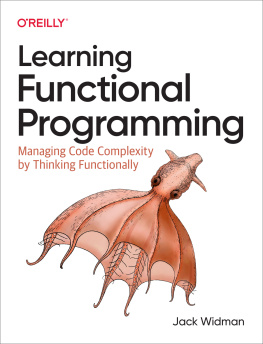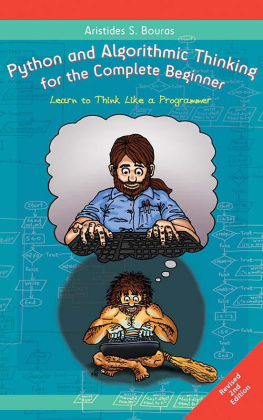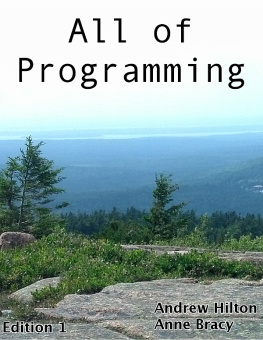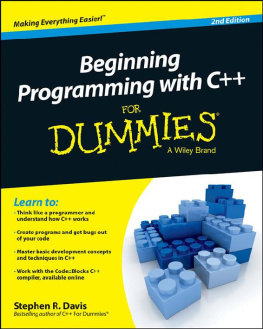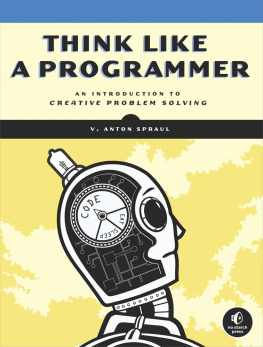PHP and Algorithmic Thinking for the Complete Beginner
Learn to Think Like a Programmer
Revised Second Edition
By
Aristides S. Bouras
PHP and Algorithmic Thinking for the Complete Beginner
Revised Second Edition
Copyright by Aristides S. Bouras
https://www.bouraspage.com
Cover illustration and design: Philippos Papanikolaou
The following are either registered trademarks or trademarks of Microsoft Corporation in the United States and/or other countries: Microsoft, Windows, IntelliSense, SQL Server, .NET Framework, Visual Studio, Visual Studio Code, VBA, Visual Basic, and Visual C#.
Oracle and Java are registered trademarks of Oracle and/or its affiliates.
Python and PyCon are trademarks or registered trademarks of the Python Software Foundation.
PHP is a copyright of the PHP Group.
Mazda and Mazda 6 are trademarks of the Mazda Motor Corporation or its affiliated companies.
Ford and Ford Focus are trademarks of the Ford Motor Company.
All crossword puzzles were created with EclipseCrossword software powered by Green Eclipse
Other names may be trademarks of their respective owners.
RCode: 200701
All rights reserved. No part of this book may be reproduced or transmitted in any form or by any means, mechanical or electronic, including photocopying, recording, or by any information storage and retrieval system, without written permission from the authors.
Warning and Disclaimer
This book is designed to provide information about learning Algorithmic Thinking, mainly through the use of PHP programming language. Every effort has been taken to make this book compatible with all releases of PHP, and it is almost certain to be compatible with any future releases of it.
The information is provided on an as is basis. The authors shall have neither liability nor responsibility to any person or entity with respect to any loss or damages arising from the information contained in this book or from the use of the files that may accompany it.
Table of Contents
Preface
About the Author
Aristides S. Bouras was born in 1973. During his early childhood, he discovered a love of computer programming. He got his first computer at the age of 12, a Commodore 64, which incorporated a ROM-based version of the BASIC programming language and 64 kilobytes of RAM!!!
He holds a degree in Computer Engineering from the Technological Educational Institute of Piraeus, and a Dipl. Eng. degree in Electrical and Computer Engineering from the Democritus University of Thrace.
He worked as a software developer at a company that specialized in industrial data flow and labelling of products. His main job was to develop software applications for data terminals, as well as PC software applications for collecting and storing data on a Microsoft SQL Server.
He has developed many applications such as warehouse managing systems and websites for companies and other organizations. Nowadays, he works as a high school teacher. He mainly teaches courses in computer networks, programming tools for the Internet/intranets, and databases.
He has written a number of books, mainly about algorithmic and computational thinking through the use of PHP, Java, Python, C++, Arduino C/C++, C#, and Visual Basic programming languages.
He is married and he has two children.
Acknowledgments
I would like to thank, with particular gratefulness, my friend and senior editor Victoria (Vicki) Austin for her assistance in copy editing. Without her, this book might not have reached its full potential. With her patient guidance and valuable and constructive suggestions, she helped me bring this book up to a higher level!
How This Book is Organized
The book you hold in your hands follows the spiral curriculum teaching approach, a method proposed in 1960 by Jerome Bruner, an American psychologist. According to this method, as a subject is being taught, basic ideas are revisited at intervalsat a more sophisticated level each timeuntil the reader achieves a complete understanding of the subject. First, the reader learns the basic elements without worrying about the details. Later, more details are taught and basic elements are mentioned again and again, eventually being stored in the brain's long term memory.
According to Jerome Bruner, learning requires the student's active participation, experimentation, exploration, and discovery. This book contains many examples, most of which can be practically performed. This gives the reader the opportunity to get his or her hands on PHP and become capable of creating his or her own programs.
Who Should Buy This Book?
Thoroughly revised for the latest version of PHP, this book explains basic concepts in a clear and explicit way that takes very seriously one thing for grantedthat the reader knows nothing about computer programming.
Addressed to anyone who has no prior programming knowledge or experience, but a desire to learn programming with PHP, it teaches the first thing that every novice programmer needs to learn, which is Algorithmic Thinking . Algorithmic Thinking involves more than just learning code. It is a problem-solving process that involves learning how to code.
This edition contains all the popular features of the previous edition and adds a significant number of exercises, as well as extensive revisions and updates. Furthermore, a brand new section provides an effective introduction to the next field that a programmer needs to work with, which is Object Oriented Programming (OOP).
This book has a class course structure with questions and exercises at the end of each chapter so you can test what you have learned right away and improve your comprehension. With 250 solved and 450 unsolved exercises, 475 True/False, about 150 multiple choice, and 200 review questions and crosswords (the solutions and the answers to which can be found on the Internet), this book is ideal for
| novices or average programmers, for self-study |
| first-year college or university students |
| anyone who wants to start learning or teaching computer programming using the proper conventions and techniques |
Conventions Used in This Book
Following are some explanations on the conventions used in this book. Conventions refer to the standard ways in which certain parts of the text are displayed.
PHP Statements
This book uses plenty of examples written in PHP language. PHP statements are shown in a typeface that looks like this.
This is a PHP statement
Keywords, Variables, Functions, and Arguments Within the Text of a Paragraph
Keywords, variables, functions (subprograms), and arguments are sometimes shown within the text of a paragraph. When they are, the special text is shown in a typeface different from that of the rest of the paragraph. For instance, $first_name = 5 is an example of a PHP statement within the paragraph text.
Words in Italics
You may notice that some of the special text is also displayed in italics. In this book, italicized words are general types that must be replaced with the specific name appropriate for your data. For example, the general form of a PHP statement may be presented as


![Aristides Bouras - C++ and Algorithmic Thinking for the Complete Beginner: Learn to Think Like a Programmer [Part 1 of 5]](/uploads/posts/book/106120/thumbs/aristides-bouras-c-and-algorithmic-thinking-for.jpg)
